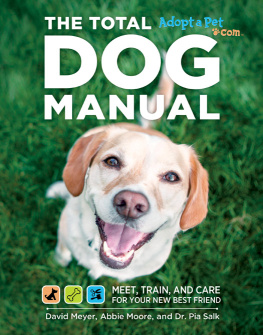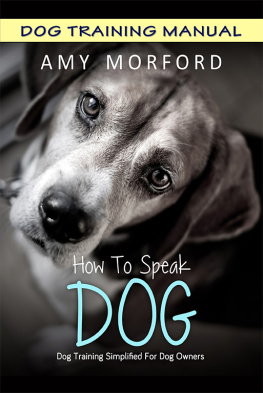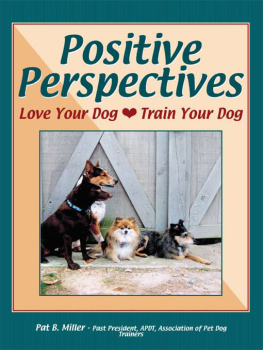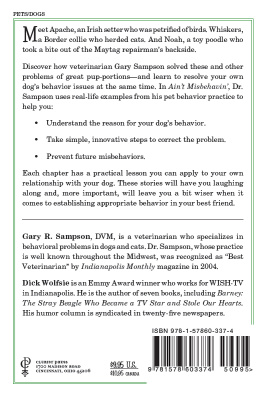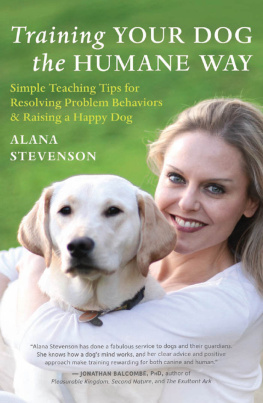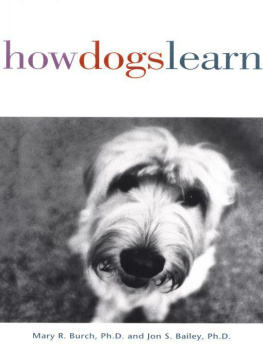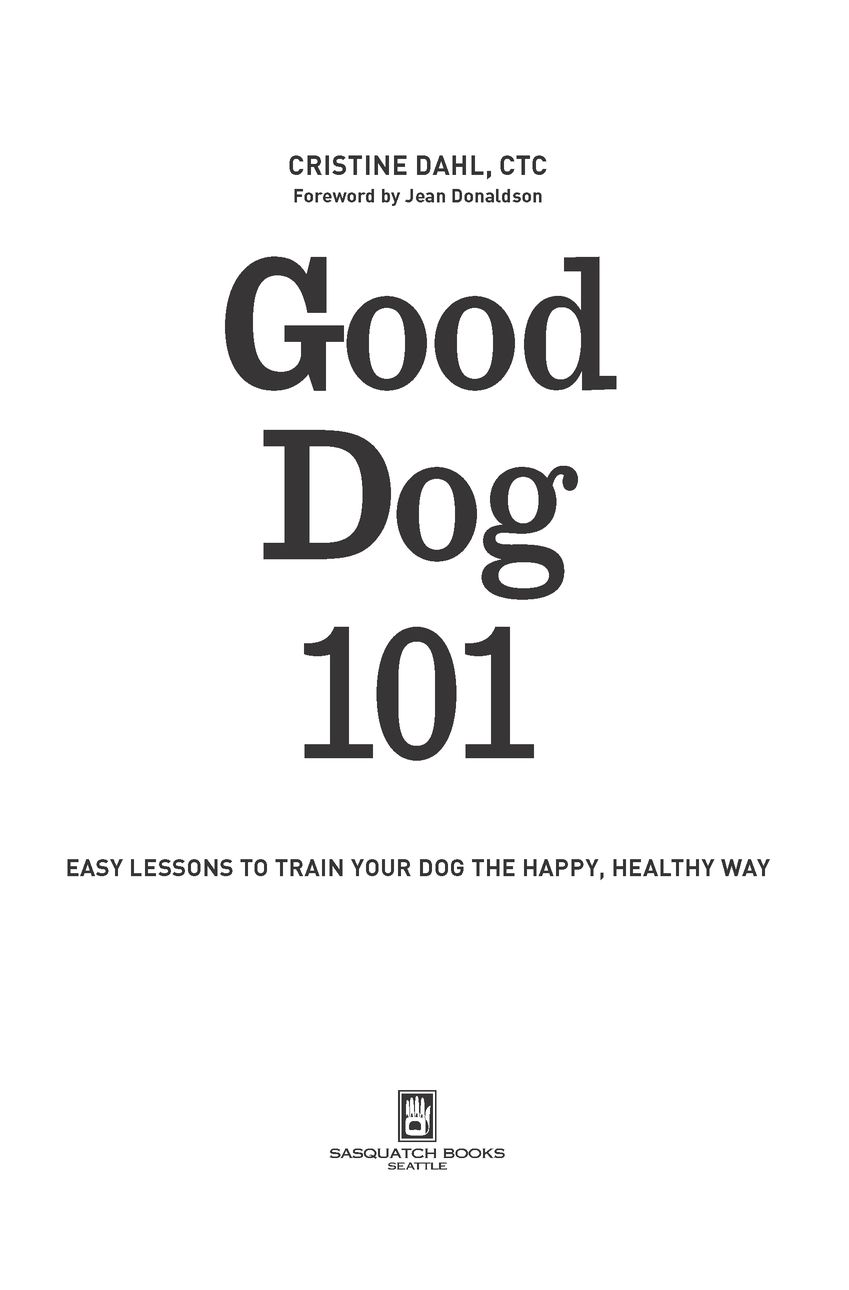Table of Contents
For Anders, without whom this book would still be a dream. Now it is a dream come true. You are my husband, my best friend, my inspiration, my sounding board, my securitymy all. And for Maddison, Oliver, and Tippens whose divine patience, endless humor, and purity have allowed me years of wonder and learning, and have provided the spark for the fire that drives me every day. To David and Susan, who not only allowed my exploration into animals of all kinds, but encouraged it with the patience of saints and the never-ending support a kid needed to follow her dream.
Foreword
A confession: I am a bona fide dog training book snob. I like what I like, which collectively turns out to be an incredibly tiny percentagea handful reallyof actual available books and products. Of course I am in no way unique in my snobbery. There are wine snobs, literary snobs and word-usage-o-philes, foodies, movie plot device nose-wrinklers, and fitness superiority snobs.
I know other dog training book snobs. We flock together. My preferred strategy to training manuals is avoidance. But because this is my field I dutifully trudge through a fair amount of the offerings. Some of them Id judge as not terrible and some, well lets just say that some have decent bits here and there (even saying that much for some books though sure is a stretch). Most training manuals I just dont like. Techie terms are woefully misused; behaviorists spend pages and pages wading us through their imaginings of what the dog is thinking, knowing, and planning; the method is Marquis de Sade; the dogs rank is solemnly discussed ad nauseum; or the writing is just painful. Usually I find a combination of three or four out of these five peeves. It makes me Eeyore but sometimes I feel like if I have to read one more treatise on preceding dogs through doorways, written by someonewere talking adults, mind you, with credit cards, a mortgage, the power of speech, and the right to bear arms, members of the most technologically advanced species that has ever walked the planetwho feels insecure about whether they are dominant over their dog or, amazingly, feels desperately control-freaky about the dogs opinion about whos dominant, I will have to jump off a cliff.
Cristine Dahl, though, was rather a breath of fresh air from the first time I met her. Smart, clear-headed, and a talented trainer. Compassionate, a dogs advocate. Conferred not a single more gift, she would be marvelous. But theres more. As a former student of mine, she was a spongy learner and natural critical thinker, someone who could communicate. As a trainer, Cristine is unsurpassed as a medium to translate the tangles of animal learning science to people with ever more compressed time and assaulted by wrong information from all sides. She likes her clients, fiercely in fact, no small feat in our profession. She has the patience for people that the rest of us have mainly for dogs. And her communication style is clean and clear. The greatest virtue of Good Dog 101 is the crispness and complete absence of impenetrable gibberish. It is fully user-friendly. The next greatest, and related, virtue is that none of it is made up. The arguments, management pointers, and training techniques are grounded in sound behavioral science.
I am so glad Cristine took the time to write this book. Seattles lucky secret is now available to all.
Jean Donaldson,
Founder and Director
San Francisco SPCA Academy for Dog Trainers
May 21, 2007
Acknowledgments
Thank you to Jean Donaldson, Janis Bradley, and Dr. James Ha, for your generous support and involvement in this process. I am grateful to Sasquatch Books for this opportunity and their continued hard work and support, and I owe a special debt of gratitude to Terence Maikels for his unmitigated patience and willingness to make this project real. And for thanks beyond words I acknowledge my clients and their furry companions. You are the reason I fight for smart, humane training and get up in the face of defeat to fight again. And for furry coats, velvety paws, wagging tails, and warm breath, I acknowledge Lucy, Coby, Puff, Bijou, Stevie, Aster, Scooter, Lucky, Sophie, Charlotte, Henry, Samson, Winston, Dude, Louie, Rufus, Spencer, Mr. Sparky, Mr. Dudley, Logan, Senta, Rocco, Yankee, Torrey, Sydney, Red, Frodo, Saffron, Polly, Whidbey, Birdie, Otis, Marco, Hugo, Missy, Cuddles, Chopper, Archie, Rosie, Kiley, Luna, Molly, Stella, Anabelle, Bailey, Huckleberry, Lily, Dahlia, Porter, James, Marina, Taylor, Sucia, Taco, Lola, Junah, Max, Comet, Roxie, Roo, Rufus, Martha, Helo, Bacci, Sylph, Royal, Alki, Brock, Grace, Marie Claire, Dexter, Marble, Finney, Hazel, Brodie, Finley, Dash, Hailey, Rooney, Poncho, Tippy, Riley, Tahoe, Klaus, Angus, Bo, Painter, Tulip, Nelson, Shasta, Sophie, Manny, Anna, Elle, Zeus, Apollo, Jack, Scarlett, Barclay, Toby, Dutch, Dakota, Troy, Daisy, Marley, Tommy, Millie, and Woody.
PART I
An Introduction to My Training Philosophy
Few things will divide a room of current day dog trainers faster than a discussion about methods, philosophies, and credentials. Unfortunately, because of the highly unregulated landscape of the professional canine field in the United States, todays companion dog owner must solely navigate through the rough terrain of theories, opinion, and hype to piece together a useful way to cultivate a well-behaved dog.
The two most popular camps consist of those who hold firmly to the traditional/military model of training and those who have abandoned those methods in search of a kinder, more scientific approach.
While the former of these styles is rooted in rich history and is the most prevalent method of training currently used in the United States, it is popularly criticized by modern animal welfare authorities such as the Society for the Prevention of Cruelty to Animals (SPCA) and the American Humane Association (AHA) as being too heavy handed, unscientific, and outdated.
The latter camp, most commonly known as positive trainers, are criticized by trainers in the traditional/military camp as being too theoretical and practically soft, and using technical methods that are too complicated for most owners to use.
The method I present in this book borrows from each of these camps, but sifts through the hype and technical challenges plaguing both styles. Its meant to give owners a user-friendly, practical, efficient, and kind way of training their dogs using techniques that fit with todays lifestyleone that is often time-starved, hectic, and busy. The style itself is borne of one hundred years of evolution of the field, but with special consideration of the sophisticated dog/human relationship of today. By retaining time-proven methods and abandoning those known to be ineffective or unkind, this new method is revolutionary.
While my approach adheres to AHA guidelines for humane training, I have not abandoned the traditional approach entirely and still employ some traditional techniques that I find useful on a practical level.
In the first section of the book, I set out to explain the basics of my teachings and how they were developed. To help you understand the current state of training, I begin with a brief history of dog training in the United States followed by an introductory and balanced look at both the traditional/military model and popular alternative methods. I have also included a chapter dedicated strictly to an indepth analysis of the traditional/military model. While it remains the most recognizable style to dog owners, this model is loaded with defects, the severity of which is seldom recognized.



